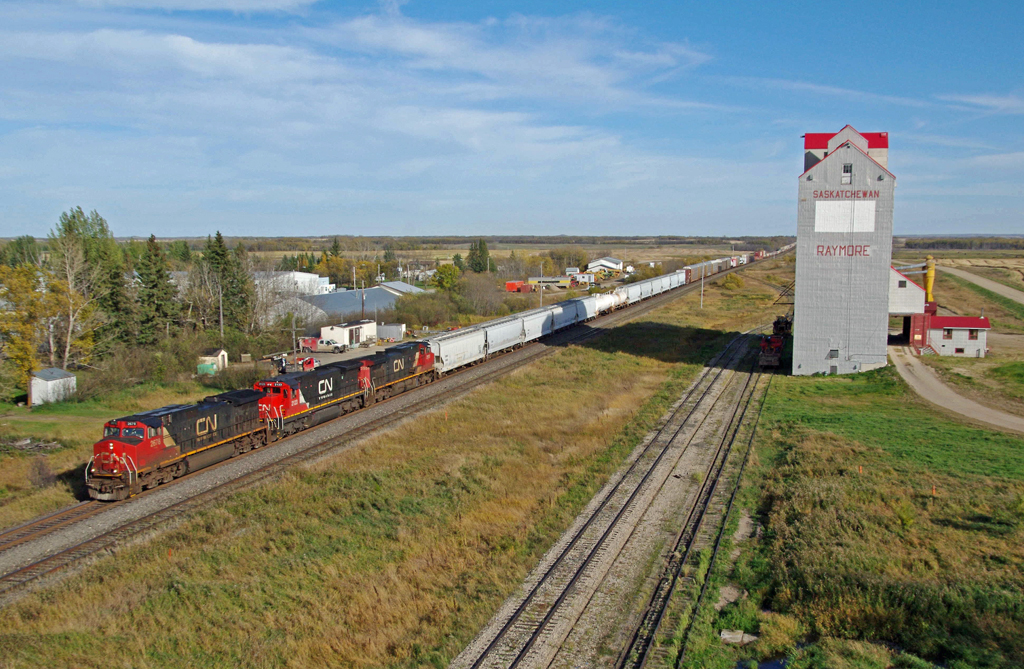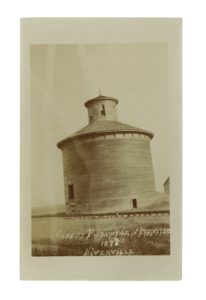
Prairie Castles along Via Rail’s Westbound Journey
Passengers aboard Via Rail’s cross-Canada train journey, the Canadian, will have the chance to see some of Western Canada’s most iconic landmarks. Known as prairie cathedrals, castles or sentinels, this list highlights some of the historic wooden grain elevators you can spot along your journey.
A Short History on the Wooden Grain Elevator
Dotted across the Prairies, wooden grain elevators are iconic landmarks to the history of agricultural, economic and landscape development across the west.
Built along the tracks, grain elevators were developed as a way to make the transportation of grain more efficient. The first grain elevator in Canada was built in 1879 in Niverville Manitoba. Thanks to the rise of agricultural companies and cooperatives such as UGG and the various Wheat Pools, alongside the development of Canada’s cross-country rail systems, by the 1930s there were nearly 6,000 grain elevators found across the prairies.

According to Jane Ross, style and features changed over the years, including the standard color of the elevator (a standard “CPR Red” until the 1950s), roof shape (a gable roof became standard after the 1920s) and the presence and type of annex (the loxstave annex was used during WWII, while metal bins appeared by the 1970s). However, it wasn’t until the 1990s that concrete silos began to take the wooden elevator’s place (Ross 2006).
As of May 2023, according to the Canadian Grain Commission, there are 400 grain elevators found collectively in Manitoba, Saskatchewan and Alberta. However, the number of wooden grain elevators within this count would be even less. In 2016, the National Trust listed the elevators as a collectively endangered place. The Trust writes, “while some have been saved through creative new uses, every year more and more of these rural landmarks are lost forever.”
Alex McPhee, Chair of the Val Marie Heritage, Culture & Youth Elevator Committee writes, “Saving industrial heritage sites takes a special kind of foresight. Our grain elevator is part of a nationwide story about a past social and economic order – still in living memory of millions, but already so hard to spot in our human landscape as it exists today. What do we take for granted now that will be critically endangered later in my own lifetime?”
Sources
Ross, Jane. “Grain Elevators.” The Canadian Encyclopedia. Historica Canada. Article published March 01, 2006; Last Edited April 24, 2015.
Earl, Paul D. The Rise and Fall of United Grain Growers : Cooperatives, Market Regulation, and Free Enterprise. Winnipeg: University of Manitoba Press, 2019. Retrieved from https://canadacommons.ca/artifacts/1879884/the-rise-and-fall-of-united-grain-growers/2629205/ on 26 Jun 2023.
“Oldest elevator in Manitoba 1878, Niverville.” Image courtesy of Peel’s Prairie Provinces, a digital initiative of the University of Alberta Libraries. http://peel.library.ualberta.ca/postcards/PC000749.html
Special thanks to the following photographers for granting permission to their work: Brent Bereska, Ben Berg, Jeannette Greaves, John Leopard, Gregory Melle, Trevor Pritchard, and David Young.
Places
Dugald Grain Elevator
Dugald, Manitoba
Wooden grain elevator found in Dugald, Manitoba. Photograph courtesy of Jeannette Greaves.
Oakville Grain Elevator
Oakville, Manitoba
Wooden Grain Elevator found in Oakville, Manitoba. Photograph courtesy of Jeannette Greaves.
Bloom Grain Elevator
Bloom, Manitoba
Private wooden grain elevator found in Bloom, Manitoba. Photograph courtesy of David Young.
Rivers Grain Elevator
Rivers, Manitoba
Rivers once had several grain elevators marking its landscape. Today, only one remains. The enduring elevator was built by United Grain Growers in 1957.
Redford Grain Elevator
Wooden grain elevator found in Redford, Saskatchewan. Photograph courtesy of Ben Berg.
Raymore Grain Elevator
Raymore, Saskatchewan
Wooden grain elevator found in Raymore, Saskatchewan. Photograph courtesy of John Leopard.
Watrous Grain Elevator
Watrous, Saskatchewan
Wooden grain elevator in Watrous Manitoba. Photo by Trevor Pritchard.
Young Grain Elevator
Young, Saskatchewan
Wooden grain elevator found in Young, Saskatchewan. Photograph courtesy of Trevor Pritchard.
Hubbard Grain Elevator
Hubbard, Saskatchewan
Wooden grain elevator found in Hubbard, Saskatchewan. Photograph courtesy of John Leopard.
Leney Grain Elevator
Leney, Saskatchewan
Wooden grain elevator found in Leney, Saskatchewan. Photograph by Trevor Pritchard.
Landis Grain Elevator
Landis, Saskatchewan
A wooden grain elevator found in Landis, Saskatchewan. Photograph courtesy of Gregory Melle.
Poe Grain Elevator
Poe, Alberta
Wooden grain elevator found in Poe, Alberta. Photograph courtesy of Tim Thompson.
Shonts Grain Elevator
Shonts, Alberta
Wooden grain elevator found in Shonts, Alberta. Photograph Courtesy of Brent Bereska.
The Spruce Grove Grain Elevator Museum
Spruce Grove, Alberta
The Spruce Grove Grain Elevator Museum is a former Alberta Wheat Pool Grain Elevator, originally built in 1958. Closing in 1995, the elevator was saved by the Spruce Grove Agriculture Society, who continue to operate the Museum today. Photograph courtesy of Tim Thompson.
Road Map
Dugald, Manitoba to Spruce Grove, Alberta
Popular VisitLists
Central Alberta Road Trip Discoveries #CanadianVisitList
Mirror, Alberta to Lacombe, Alberta 7 places
There are many hidden gems to discover on a mini road trip through Central Alberta
View VisitList
A Historical Places #CanadianVisitList for all Seasons
Prince William, New Brunswick to Fredericton, New Brunswick 5 places
Enjoy historical places year-round with this fun list!
View VisitList
Pemberton Museum
Pemberton, British Columbia 1 place
Wonderful museum, showcases old heritage and culture of cute town.
View VisitList
The ARTs & CRAFTS MOVEMENT in Canada & Quebec #CanadianVisitList
Montréal, Québec 9 places
The ARTs & CRAFTS MOVEMENT in Quebec as seen through dedicated conservation practices.
View VisitList
